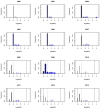A multicategory logit model detecting temporal changes in antimicrobial resistance
- PMID: 36454890
- PMCID: PMC9714861
- DOI: 10.1371/journal.pone.0277866
A multicategory logit model detecting temporal changes in antimicrobial resistance
Abstract
Monitoring and investigating temporal trends in antimicrobial data is a high priority for human and animal health authorities. Timely detection of temporal changes in antimicrobial resistance (AMR) can rely not only on monitoring and analyzing the proportion of resistant isolates based on the use of a clinical or epidemiological cut-off value, but also on more subtle changes and trends in the full distribution of minimum inhibitory concentration (MIC) values. The nature of the MIC distribution is categorical and ordinal (discrete). In this contribution, we developed a particular family of multicategory logit models for estimating and modelling MIC distributions over time. It allows the detection of a multitude of temporal trends in the full discrete distribution, without any assumption on the underlying continuous distribution for the MIC values. The experimental ranges of the serial dilution experiments may vary across laboratories and over time. The proposed categorical model allows to estimate the MIC distribution over the maximal range of the observed experiments, and allows the observed ranges to vary across labs and over time. The use and performance of the model is illustrated with two datasets on AMR in Salmonella.
Copyright: © 2022 Aerts et al. This is an open access article distributed under the terms of the Creative Commons Attribution License, which permits unrestricted use, distribution, and reproduction in any medium, provided the original author and source are credited.
Conflict of interest statement
The authors have declared that no competing interests exist.
Figures






Similar articles
-
A hierarchical Bayesian latent class mixture model with censorship for detection of linear temporal changes in antibiotic resistance.PLoS One. 2020 Jan 31;15(1):e0220427. doi: 10.1371/journal.pone.0220427. eCollection 2020. PLoS One. 2020. PMID: 32004341 Free PMC article.
-
Potential Information Loss Due to Categorization of Minimum Inhibitory Concentration Frequency Distributions.Foodborne Pathog Dis. 2018 Jan;15(1):44-54. doi: 10.1089/fpd.2017.2301. Epub 2017 Oct 17. Foodborne Pathog Dis. 2018. PMID: 29039983
-
A comparison of modelling options to assess annual variation in susceptibility of generic Escherichia coli isolates to ceftiofur, ampicillin and nalidixic acid from retail chicken meat in Canada.Prev Vet Med. 2018 Nov 15;160:123-135. doi: 10.1016/j.prevetmed.2018.08.009. Epub 2018 Aug 25. Prev Vet Med. 2018. PMID: 30197208
-
Population distributions of minimum inhibitory concentration--increasing accuracy and utility.J Appl Microbiol. 2006 May;100(5):999-1010. doi: 10.1111/j.1365-2672.2006.02842.x. J Appl Microbiol. 2006. PMID: 16630000
-
Establishing Statistical Equivalence of Data from Different Sampling Approaches for Assessment of Bacterial Phenotypic Antimicrobial Resistance.Appl Environ Microbiol. 2018 Apr 16;84(9):e02724-17. doi: 10.1128/AEM.02724-17. Print 2018 May 1. Appl Environ Microbiol. 2018. PMID: 29475868 Free PMC article.
References
-
- European Food Safety Authority, and European Centre for Disease Prevention and Control The European Union Summary Report on Antimicrobial Resistance in zoonotic and indicator bacteria from humans, animals and food in 2017/2018. EFSA Journal. 2020;18(3):6007 doi: 10.2903/j.efsa.2020.6007 - DOI - PMC - PubMed
-
- Agresti A. Categorical Data Analysis. Hoboken, New Jersey: Wiley; 2002.
Publication types
MeSH terms
Substances
LinkOut - more resources
Full Text Sources
Medical

